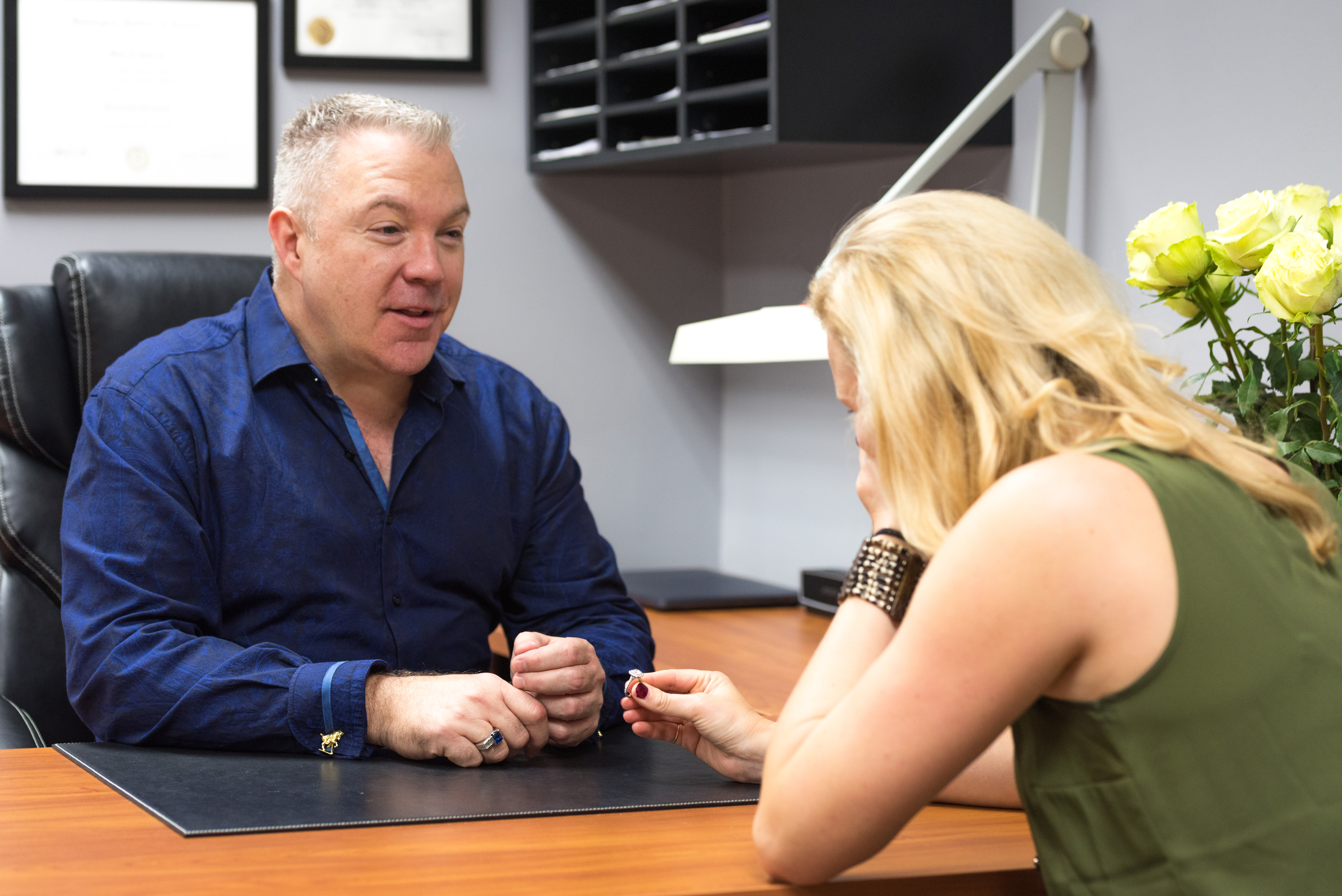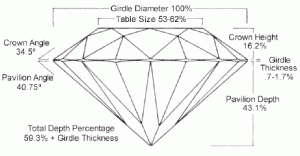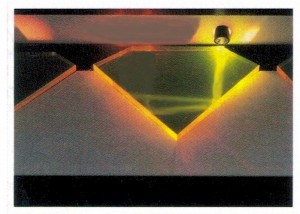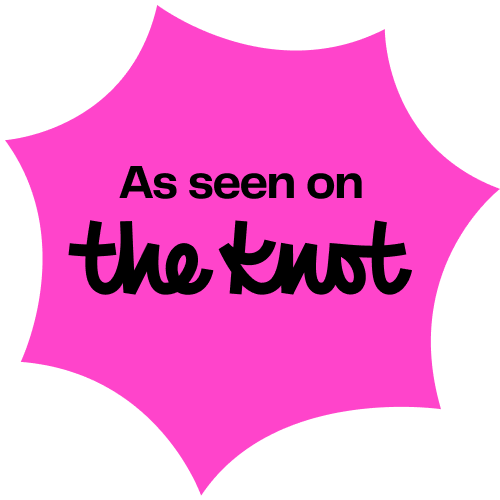In this article you will learn about the different qualities of diamonds using the grading system from the Gemological Institute of America. The purpose of this article is to introduce you to diamonds and to take some of the mystery and confusion out of purchasing a diamond by making you a more informed consumer.
The 6 (Yes, 6) “C’s”
 If you have ever purchased a diamond, your jeweler might have mentioned what we call the four C’s of a diamond: Cut, Color, Clarity, and Carat Weight. In addition to the aforementioned, two more C’s should be considered. “Cost,” of course, is of vital importance to every consumer. The most important “C” of all, however, is “Confidence” in the jeweler from whom you are buying. Only an experienced and educated jeweler with the proper gemological credentials has the ability to properly guide you with your diamond purchase.
If you have ever purchased a diamond, your jeweler might have mentioned what we call the four C’s of a diamond: Cut, Color, Clarity, and Carat Weight. In addition to the aforementioned, two more C’s should be considered. “Cost,” of course, is of vital importance to every consumer. The most important “C” of all, however, is “Confidence” in the jeweler from whom you are buying. Only an experienced and educated jeweler with the proper gemological credentials has the ability to properly guide you with your diamond purchase.
Before purchasing a diamond, it is important to get a general idea of the type of diamond that can be bought for the amount of money you wish to spend. A slightly larger stone can be purchased for a given amount in exchange for a slight reduction in the color and/or clarity of the stone. Our general recommendation when buying a diamond, however, is to stay with better quality stones rather than greatly diminishing the quality for the sake of size. That does not mean that the stone cannot have some minor inclusions or that the stone cannot have some body color to moderate the price, as long as neither one of these qualities is carried to the lower extremes. When balancing the characteristics of the stone you wish to purchase with the amount of money you are comfortable spending, never sacrifice the cut of the diamond. A diamond with a poor cut, as we have learned, will never emit its maximum beauty no matter how good the other characteristics of the diamond may be. There are many stones that may have a number of imperfections and yet, when mounted, still look beautiful. The same applies to the color of a diamond. By purchasing a stone with a slight tint (which might not even be noticeable when the diamond is mounted), the price of the diamond can be reduced while maintaining the size of the stone you wish to purchase.
Differences in cutting and other gemological factors can cause the price of two diamonds with the same weight, color, and clarity grades to vary in price by as much as 70%. (Even for round diamonds with the same GIA cut grade, prices can still vary by 30%!) It is very difficult to shop for diamonds since it is almost impossible to compare the quality of a diamond from one store to another. Therefore, instead of shopping for a diamond, look for an experienced and qualified jeweler. Shop as carefully for your jeweler as you would for your doctor or lawyer, since you will have to depend on him to help you with your decision. When you talk to a jeweler, see how he approaches subjects such as diamond grading and the usage of the grading system. Pay particular attention as to whether he places emphasis on the cutting and proportioning of his diamonds, since many jewelers find cut grading a difficult topic which even they, themselves, do not fully understand. Unless the jeweler has gemological training and years of experience in the jewelry business, these are the areas that he is most likely to gloss over or totally disregard. It is just as important to deal with a well-established company. Remember, M. Martin & Co. was established in 1939 and will continue to serve you for many years to come.
Tips on Buying Diamonds
CHECK THE CREDENTIALS OF THE JEWELER FROM WHOM YOU ARE BUYING
While many jewelers may be well-intentioned, their lack of gemological training may hinder your purchase of a quality diamond. Even certificates accompanying a diamond should be double-checked by a credentialed gemologist for accuracy. Always ask the jeweler beforehand if he is a GIA Graduate Gemologist and ask to see his credentials. At M. Martin and Company you always meet only with a GIA Graduate Gemologist.
PURCHASE A DIAMOND FROM A WELL-ESTABLISHED STORE
The best guarantee in the world is of little value if the store will not honor it, or if the store goes out of business. M. Martin and Company was established in 1939 and is now one of the oldest jewelry stores in Chicago.
PURCHASE FROM AN EXPERIENCED, ACCREDITED GEMOLOGIST WHO CAN VERIFY A CERTIFICATE’S ACCURACY
Larger, quality diamonds should be purchased with an accompanying certificate from an independent laboratory. However, the consumer must realize that the certificate should only be used as a guideline to the diamond’s individual characteristics and not as a final determinant of the diamond’s overall quality. Even if the diamond you are purchasing has a certificate, it is still important to purchase the diamond from an accredited and experienced gemologist who can verify the accuracy of the certificate. Some smaller diamonds, and diamonds already set in jewelry, will not necessarily have a laboratory certificate. In this situation, the consumer will have to trust the store’s determination of the diamond grades. Unfortunately, it is not uncommon for unethical stores to substantially inflate diamond grades. This is why it is important to purchase your diamond from a reputable, established jeweler.
TRY TO LOOK AT YOUR DIAMOND IN A NATURAL LIGHT
Most stores display their diamonds under strong halogen lighting that is made especially for jewelers. You want your diamond to sparkle on its own and not because of an intense light source shining on it.
AVOID BEING MISLED BY SALE PRICES THAT GIVE THE APPEARANCE OF A LARGE DISCOUNT
Stores can mark up jewelry as much as they want in order to give significant (though generally fictitious) “discounts.” Often, items of jewelry that are advertised in newspapers, catalogues, and on the internet as “on-sale” are what we call promotional items — low quality jewelry which is advertised as a “leader” to lure you into their store (or cyber store).
USE YOUR OWN EYES TO JUDGE THE OVERALL APPEARANCE OF A DIAMOND
Ask to inspect the stone under ten-power magnification. When possible, ask to see other diamonds with which you can compare the diamond you are buying. Try to use your own judgment as to the beauty that a stone projects rather than relying solely on the stone’s ratings. Because ratings cannot take into account all of the subjective and non-subjective factors needed to evaluate a diamond, they can only give you a general idea of the quality of a stone. Remember that stones with the same color, clarity, and weight can vary in price by as much as 70%.
IT IS IMPORTANT TO REALIZE THAT ONLY ABOUT 5% OF ALL DIAMONDS ARE CUT TO THE PROPORTIONS NECESSARY TO GIVE THEM MAXIMUM BRILLIANCE AND BEAUTY.
Ironically, rough (uncut) diamonds of high color and clarity are as likely to be cut into “off-make” stones as low grade rough. The reason for this is that when a cutter is cutting a diamond from high-quality expensive rough, leaving excess weight on the stone may bring him a higher market price than if he reduces the weight by properly proportioning the diamond. Be sure that you deal with a jeweler who is well versed in all aspects of cutting and proportioning, and who maintains high standards for cut quality.
DIAMONDS THAT ARE CUT IN “OFF-MAKE” PROPORTIONS GIVE THE CONSUMER THE ILLUSION THAT HE IS GETTING A BETTER VALUE
However, just the opposite is true. Take the previously mentioned example of the .85 carat diamond that was cut with improper angles to bring the weight up to one carat. When a jeweler buys such a stone, he buys it not at the one carat price, but at the .85 carat price (the price the diamond would have cost had it been cut properly). However, the jeweler then sells the diamond to his customer at the one carat price because the diamond does indeed weigh one carat.
IDEALLY PROPORTIONED DIAMONDS WILL CONTINUE TO BE A BETTER VALUE THAN “OFF-MAKE” STONES
If an “off-make” diamond is sold or traded, the value of the stone will be based on the reduced weight to which the diamond should have been cut had it been properly proportioned, and not based on its current weight. This calculation is the “weight correction factor” of the diamond, and is a basic technique used by gemologists when evaluating a diamond. Therefore, the resale or trade-in value of an “off-make” stone is considerably less than that of a well proportioned diamond.
LABORATORY GRADING REPORTS HAVE LIMITATIONS
Do not depend on the depth and table parameters stated on a certificate to guarantee that you have a diamond with a quality cut. By using various techniques, the cutter can cut a poorly proportioned stone and still have its parameters fall within the numerical laboratory guidelines of a properly cut diamond. Therefore, the parameters established by the various laboratories can only be used to eliminate improperly cut diamonds; they cannot be used to ensure that the diamond is properly cut. GIA’s new cut grading system for round diamonds can help the consumer eliminate improperly cut diamonds. However, the system is just one of laboratory measurements, and even stones in its top cut grade of “excellent” can vary dramatically in beauty, brilliance, and, of course, price. Another example relates to the quality of the diamond material. Some diamond material may be “grainy” under a microscope, but the very best shows as “crystal.” Since the laboratories have no way yet of measuring this characteristic, what may be a serious deficiency is not noted on the certificate.
EACH DIAMOND GRADE COMBINATION IS NOT JUST ONE SINGLE PRICE
When researching diamond prices, you will find that for any specific weight, color, and clarity combination, there will not be just one single price but a wide range of prices depending on the stone’s cut and other gemological factors. If looking at a listing of diamonds from a store or internet company, it is logical to assume that diamonds at the lower end of the stated price range are going to be the weakest stones in that grade. However, the opposite is not true. Stones at the high end of the price range may still not be good stones–they may just be the best that particular store or internet sells.
THEORETICAL PROPORTIONS OF A MODERN CUT DIAMOND

A diamond that is beautiful to our eyes will have a balance of two components of light, namely brilliance and dispersion. The brilliance of the diamond comes from light reflecting from the bottom, or pavilion, facets of the diamond. The dispersion of the diamond comes from the upper, or crown, facets of the diamond as these facets act like a prism breaking the light into the colors of the rainbow. Thus, when I say that a diamond is beautiful, I am saying that it has maximum brilliance as it gathers light and returns it to our eyes, and maximum dispersion as it shows a plethora of rainbow colors.
There are a number of major shapes of diamonds that can be found on the market today. These shapes can be divided into two categories: the round (brilliant) cut, and the fancy cuts, which include the marquise, pear, oval, heart, emerald, princess, radiant, asscher and cushion. Since each cut has its own special beauty and qualities, the shape that a person chooses depends only on personal preference.
Each diamond is cut with a specified number of facets. The round diamond, which is also called the brilliant cut, has a total of 58 facets. Thirty-two of these facets are above the girdle, and twenty-four facets are below it. In addition, the largest facet, which is located on the top of the stone, is called the table. The point at the bottom of the stone where the facets meet is called the culet.

Why is it so critical that a diamond be properly proportioned? As demonstrated in the illustration of a properly cut diamond, light entering through the table and crown facets of the diamond is reflected across the inside of the stone and back out the top of the stone.

If the stone is cut too deep, the light entering the diamond hits the pavilion facets at the wrong angle, and much of the light will leak out the sides of the stone.

If the stone is cut too shallow, much of the light may leak out the bottom of the stone. The pictures of the deep stone and the shallow stone have been shown exaggerated for illustrative purposes only.

Diamond material varies from stone to stone affecting the transparency of the stone. Poor density or grainy material will disperse light inside the diamond resulting in a weak looking stone. GIA does not yet have a way to measure this characteristic, and thus there is nothing on the certificate that may indicate if a diamond is cut from sub-par material.
Although there are small variations allowed in the ideal cut stone, once a stone is cut outside of these limits, the brilliance of the diamond will be noticeably diminished. (We are only discussing the round diamond here. Although the same principles apply to the fancy shapes, their proportions are different and the subject is much too complex to be analyzed here.) If you want maximum beauty and brilliance from the diamond you are about to purchase, you should select a stone that is extremely well cut. A stone that is cut either too deep or too shallow cannot possibly give you maximum brilliance.
Next I will discuss the color and clarity of the diamond, using the grading scales of the Gemological Institute of America to evaluate each of these characteristics. These scales for color and clarity were created in the early 1950’s and were intended primarily for use by jewelers. It was not until the late 1970’s that they were promoted to the general public as people became interested in knowing more about how diamonds were judged and graded.
GIA’s color scale begins with the letter D and continues successively downward to the letter Z. When we talk about the color grade of a diamond, we are referring to the body color of that diamond as seen from the side of the stone under certain lighting conditions. As we move along the scale, the body color of a diamond may range from one having a very fine white color, to one having a very slight tint, to one having a very noticeable tint. Generally, the tint will be of a yellowish color, although some stones may have a brownish, grayish, or green tint (green is the hardest color for even an expert to detect and is the color that affects the value of the stone most negatively.) To determine the color grade of a diamond, the jeweler uses a master set of pre-graded diamonds. The jeweler matches the body color of the stone he is grading against the stones in the master set.
COLOR SCALE

CLARITY SCALE

Clarity grading is accomplished by inspecting the diamond under ten-power magnification, using either a microscope or a jeweler’s loupe. The clarity grading scale begins with a rating of flawless. A flawless diamond has no inclusions under ten-power magnification when viewed by a trained eye. Other ratings on the scale include VVS-1 and VVS-2 (very, very, slightly included), VS-1 and VS-2 (very slightly included), SI-1 and SI-2 (slightly included), and I-1, I-2, and I-3 (imperfect). There is also an SI-3 grade between SI-2 and I-1 that is used by some laboratories. When judging clarity, the jeweler considers the size, nature, number, position, and relief of the inclusions and then makes an educated decision as to where this diamond would fall on the scale.
Carat weight is the last major criterion that jewelers take into consideration when evaluating a diamond. Today, digital scales make weighing diamonds both fast and accurate. The weight of a diamond is expressed in carats and points. There are one-hundred points to the carat. A diamond that is 48 points, for example, is 48/100 of a carat — or slightly under one-half carat. As diamonds increase in size, the price per carat goes up very rapidly. A one carat diamond of a particular quality may be twice the weight of a half-carat diamond of the same quality, but it may cost three times as much. The explanation for this is simple. As stones increase in size, they become rarer and their price per carat increases.
In reality, however, there are many additional characteristics that the gemologist takes into consideration when evaluating a diamond. These may include the quality of the polishing, the symmetry of the diamond, variances in the quality of the diamond material (which resulted from changing conditions of temperature and pressure in nature as the rough diamond crystal was being formed), and numerous other gemological factors. As we learn how to use the GIA grading system, we will concern ourselves only with the four basic factors, but keep in mind that there are many intangible characteristics that cannot be measured and do not appear on the certificate. One of the most important of these non-measurable characteristics is the transparency of the diamond material itself. This refers to whether the material is “grainy” in nature or whether it is of the more desired “crystal” quality.
It is important that the consumer understand how to use the grading system in order to obtain the desired balance of characteristics in the diamond he wishes to purchase. As we have already discussed, the beauty and brilliance of the diamond come from the cutting, the proportioning, and the quality of the diamond material. The color and clarity scales refer only to the rarity of the material from which the stone is cut. Although a diamond may have a high color and clarity grade on the GIA scale, unless it has an excellent cut, it will not be a beautiful stone. Therefore, if you want your stone to have maximum beauty and brilliance, we suggest that you buy a finely cut and polished diamond. You should then vary the color grade, clarity grade, and weight of the diamond to stay within your budget.
Some important observations should be made with respect to the different grading systems. On the color grading scale, differences in adjoining color grades are extremely slight. The average consumer will have difficulty observing differences in the color grades of diamonds unless they are three or four grades apart. As a matter of fact, if a gemologist is trying to grade the color of a mounted diamond, he may put the diamond into a three-grade range instead of attempting to pinpoint the exact grade of the diamond. It is necessary to remember that a diamond is color graded from its side, and that when mounted the diamond will only be viewed in the face-up position. Many times diamonds that have a very slight body tint and are very well cut will not show any color when viewed from the top of the stone. With regard to the clarity grading system, although diamonds may be classified within the same clarity grade, they can still be very different. No two diamonds can possibly have identical inclusions, or identifying characteristics. Each clarity grade is a range within itself; it is not an absolute point on the scale. For example, there may be two diamonds which have each been classified as SI-1. However, if one stone borders on being a VS-2, and the other stone borders on being an SI-2, then even though the stones are both classified as SI-1, they will look very different inside.
Even an experienced and trained gemologist may encounter limitations when using the grading system. It is not uncommon for two gemologists to examine the same stone and grade it slightly differently (though the grading should be close). Borderline situations of color and clarity may prove to be particularly troublesome, and a judgment call must be made. The most difficult of all these judgment calls, however, is the determination of the quality of the cutting and the proportioning of the diamond.
Ninety-five percent of all diamonds cut today are not cut to achieve optimal brilliance. The rough diamond that is mined from the earth is generally a very irregularly shaped crystal that must be cut and polished. We stated earlier that the ideally cut diamond must be cut with very precise angles to emit maximum beauty. The rough diamond does not have these proper angles. Aside from the fact that not every cutter has the experience or ability to cut a quality diamond, with modern technology, a highly skilled cutter can cut a stone to achieve its optimal beauty, assuming the rough diamond accommodates this procedure. However, when a cutter cuts a diamond to ideal proportions, he will have a greater weight loss from the rough diamond than if he cuts the diamond too deep, too shallow, or with shifted crown and pavilion angles. In other words, the cutter can cut the rough diamond to achieve either maximum weight or maximum beauty, but not both. Diamonds that are cut in “off-make” proportions have a greater weight yield from the original rough diamond. By cutting a diamond to obtain the maximum weight yield, the cutter can cause a consumer to believe that he is obtaining a better value for his money. As an example, from a specific rough diamond a cutter might have the option of cutting a perfectly proportioned .85 carat diamond or leaving extra weight on the diamond by cutting a high crown, thick girdle, and/or deep pavilion, thereby creating an “off-make” diamond weighing one carat. By cutting the diamond to the weight of one carat, the cutter is unable to maintain ideal proportions for the diamond, and the diamond loses much of its brilliance and beauty. This practice proves to be advantageous for the cutter, however, because the increased weight on the stone enables him to receive a higher price in the marketplace. Unfortunately, it is the consumer who ultimately pays for this excess weight.
Many jewelers, especially in the United States, promote only the color and clarity grades of the diamonds that they sell, while ignoring the quality of the cut. By purchasing cheaper, “off-make” stones, a jeweler can give the customer the impression that his stone is a better deal than the stones of the same size and grade that may be offered to the customer by other jewelers. This is a very common practice, and as long as it continues, there is little incentive for the diamond cutter to cut ideally proportioned diamonds. Many consumers are being taught the improper practice of shopping for diamonds by color and clarity grade alone. Often, their shopping consists of going from jeweler to jeweler, writing down the color grades, clarity grades, and prices of the diamonds that they are shown, and then incorrectly assuming that the highest color and clarity grade at the lowest price is the best deal. Frequently, the “best deal” is just the diamond that has the poorest cut. In the case of the round diamond, which now has a cut grade, consumers have added a cut grade to their criteria, but may be unaware of the fact that diamonds that rank low in even the highest cut class may not have the optimum beauty they desire for their diamond. For all the other shapes, although cutting parameters have been established by various organizations in the industry (and not all agree), it is unlikely GIA will be able to establish a workable system for grading these diamonds due to the many intertwined variables involved in determining cut quality.





